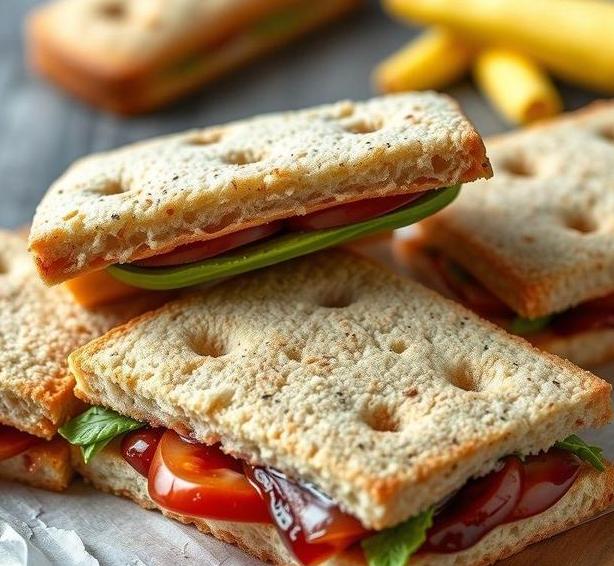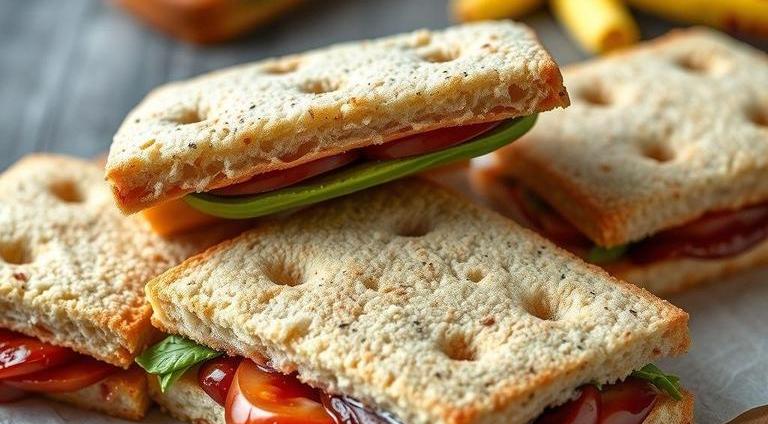Uncrustables sandwiches have become a staple in many households, offering a convenient, no-fuss solution for meals and snacks, especially for busy families, kids, and on-the-go adults. These frozen, pre-made sandwiches are sold in a variety of flavors, from classic peanut butter and jelly to newer options like hazelnut spreads and even savory fillings. But, like with all food products, people often wonder about their shelf life, proper storage methods, and how long these little bites of convenience can last before going bad.
In this guide, we’ll dive deep into the topic of Uncrustables shelf life, signs of spoilage, and expert storage tips to help you maximize their freshness and prevent any waste. If you’re unsure how long those frozen sandwiches can sit in your pantry or freezer, or whether they’re still good to eat after a few months, read on for all the answers.
Can Uncrustables Sandwiches Go Bad?
Yes, like any food product, Uncrustables can go bad, but the key factor here is how you store them. While they’re designed to be shelf-stable in their frozen state and sealed packaging, improper storage or long exposure to fluctuating temperatures can cause them to spoil.
The good news is that Uncrustables are less likely to go bad quickly if stored properly, but they don’t last indefinitely. Over time, they’ll lose their flavor and texture, and there’s even a chance for them to grow mold or harbor bacteria if exposed to moisture or warmth. So, just because you find an old pack in the back of your freezer, doesn’t mean it’s still safe to eat. The good news is that the signs of spoilage are pretty clear if you know what to look for.
Shelf Life For Uncrustables Sandwiches

Uncrustables sandwiches have a relatively long shelf life, especially when frozen, which is one of the reasons they’re so popular. Let’s break it down:
-
Frozen (Unopened And Stored Properly)
- Typically, Uncrustables can last for up to 8 months in the freezer if stored properly. This is under optimal conditions, which means they’re sealed in their original packaging and kept at a consistent freezing temperature.
-
Refrigerated (After Thawing)
- Once you thaw an Uncrustable, its shelf life decreases significantly. Generally, you should eat them within 1-2 days after thawing in the fridge. This applies to both the classic peanut butter and jelly versions as well as any other fillings that may have a different moisture or fat content.
-
Room Temperature (Short Term)
- Uncrustables can be kept at room temperature for a short period, like in a lunchbox for a few hours, but you shouldn’t leave them out for more than 6 hours. After that, the sandwich can spoil, especially because of the peanut butter and jelly filling, which can be prone to bacterial growth if not kept cool.
If you’ve had a package in your freezer for longer than 8 months, it’s not necessarily dangerous to eat, but the texture and flavor might not be as fresh. They may also suffer from freezer burn, which impacts taste and quality.
Common Signs Of Spoilage
Knowing when your Uncrustables have gone bad can be tricky if you’re not familiar with the signs. Fortunately, spoiled Uncrustables don’t hide their issues. Here’s what to look out for:
-
Freezer Burn
- If your Uncrustables have been frozen for too long or improperly stored, you might notice that they appear discolored or have white, frosty patches on the surface. This is called freezer burn, and it happens when the sandwich has been exposed to air in the freezer, causing dehydration and loss of flavor. While it’s safe to eat, the texture and taste will be compromised.
-
Off Smell
- If you open the packaging and notice an unpleasant or sour smell, it’s a clear indication that the sandwich has gone bad. For peanut butter and jelly Uncrustables, a rancid smell could signal that the peanut butter or the jelly has begun to break down.
-
Mold
- One of the most obvious signs of spoilage is mold, which might appear as fuzzy, green, or blue spots on the bread or filling. If you spot mold, it’s important to discard the sandwich immediately. Mold growth can be harmful and is an immediate indication that the sandwich is no longer safe to eat.
-
Weird Texture
- If you notice that the bread feels slimy or overly hard, or if the filling has separated into a watery liquid, it might be a sign of moisture buildup or bacterial contamination. The texture of the peanut butter and jelly might also look runny or have an odd consistency.
-
Color Change
- Pay attention to any color changes in the bread or filling. If the bread has turned a shade of brown, or the jelly has become overly dark or opaque, these could be early signs of spoilage.
How To Store Uncrustables Sandwiches?

Proper storage is key to ensuring your Uncrustables remain fresh for as long as possible. Here are the best practices for storing them:
-
In The Freezer (Ideal)
- Store unopened Uncrustables in their original packaging. It’s sealed for a reason – that seal helps keep out air, moisture, and contaminants, extending the sandwich’s shelf life.
- Use a freezer bag: If you’ve opened the packaging but have leftover sandwiches, place them in a freezer-safe resealable bag to keep them fresh. This prevents moisture from getting in and affecting the quality.
- Set a consistent temperature: Your freezer should stay at 0°F (-18°C) to keep the Uncrustables in their best condition. Any fluctuations in temperature can result in freezer burn or melting and refreezing, both of which will degrade the sandwich.
-
After Thawing (Refrigerate)
- Once thawed, store Uncrustables in the fridge. They’re best eaten within 1-2 days once thawed, so try to consume them quickly. Don’t refreeze them after they’ve thawed, as this can cause texture and flavor issues.
- Don’t leave them at room temperature for too long: Keep track of how long the sandwiches have been out. At room temperature, they should be eaten within a few hours.
- Keep Them Wrapped: Whether stored in the freezer or fridge, always ensure the sandwiches are wrapped or sealed properly. Air exposure leads to drying out or contamination, so make sure the packaging stays intact.
Expert Tips
- Check Expiration Dates: Always check the packaging for any expiration date or best-before label to ensure freshness.
- Use within 6 months: To get the best flavor and texture, try to eat frozen Uncrustables within 6 months. Although they last up to 8 months, consuming them sooner helps maintain quality.
- Prevent Freezer Burn: If you’re storing them for an extended period, wrap them in plastic wrap or foil before putting them into a freezer bag for an extra layer of protection against freezer burn.
- Pack with Ice Packs: If you’re taking Uncrustables on a trip or packing them for lunch, include an ice pack to keep them cool and fresh throughout the day.
FAQs
Do Uncrustables Sandwiches Expire?
Yes, Uncrustables sandwiches do have an expiration date printed on the packaging. They typically last for several months if kept frozen, but once thawed, they should be consumed within a few days.
How Long Can You Keep Uncrustables In The Freezer?
Uncrustables can be kept in the freezer for up to 8 months without significant quality loss. However, for the best taste and texture, it’s recommended to consume them within 3 months.
Can Uncrustables Go Bad After Being Thawed?
Yes, once thawed, Uncrustables sandwiches should be eaten within 1-2 days if kept in the refrigerator. After this period, the quality of the bread and filling may degrade, and the sandwich could spoil.
What Happens If You Eat An Expired Uncrustable?
If you eat an expired Uncrustable, you may experience foodborne illness, especially if the sandwich has been thawed and left unrefrigerated for too long. The bread can become soggy and the filling may spoil, leading to potential stomach discomfort.
How Can You Tell If An Uncrustable Has Gone Bad?
Signs that an Uncrustable has gone bad include mold growth, a sour or off smell, or a change in color or texture, especially in the filling. If the sandwich has been left out at room temperature for more than 2 hours, it is best to discard it.
Can You Refreeze Uncrustables After They’ve Been Thawed?
Refreezing Uncrustables after thawing is not recommended because it can negatively affect the texture and quality of the bread and filling. Freezing and thawing multiple times increases the risk of spoilage.
Do Uncrustables Need To Be Refrigerated Once Thawed?
Yes, once an Uncrustable sandwich is thawed, it should be kept in the refrigerator to prevent spoilage. Leaving it out at room temperature for more than a few hours increases the risk of bacterial growth.
Can Uncrustables Go Bad If They Are Stored Improperly?
Yes, if Uncrustables are not stored properly, they can go bad. Keeping them at room temperature for long periods, or allowing them to thaw and then refreeze, can cause them to spoil prematurely.
Can Uncrustables Be Eaten After The ’sell By’ Date?
The ’sell by’ date on the packaging is an indication of when the product should be sold by, not necessarily when it will go bad. However, the quality of the sandwich may start to decline as it approaches this date, especially if it’s not kept frozen.
Are Uncrustables Safe To Eat If The Bread Is Slightly Dry Or Crumbly?
If the bread is dry or crumbly but there is no mold or off smell, it is generally still safe to eat. However, the texture may not be as pleasant, and it may be a sign that the sandwich has been stored for a while.